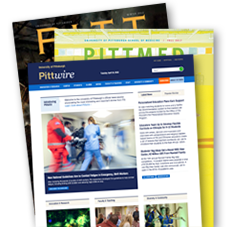Pitt, Westinghouse Partner to Hold 'High School Innovative Design Competition' April 7
PITTSBURGH-How would you learn more about the physics of trajectories: (a) Reading a textbook, or (b) Building a catapult that launches tennis balls 75 feet away?
If you picked "b," you're thinking like some Pittsburgh high school students who will be taking part in a design competition sponsored by the University of Pittsburgh's School of Engineering (ENGR) and Learning Research and Development Center (LRDC), with support from Westinghouse Electric Company and the National Science Foundation (NSF).
Throughout the academic year, hundreds of local high school students have been designing creative solutions to difficult challenges in their science classes in an effort to get them to think like engineers and scientists simultaneously. On April 7, the best students from each class will demonstrate their designs in the High School Innovative Design Competition at George Westinghouse Research and Technology Park, 1340 Beulah Rd., Churchill. The competition begins at 9 a.m., and the awards ceremony is at 12:45 p.m.
"Students begin to think about their needs or the needs of others, and they learn science concepts by starting there," said Matthew Mehalik, a research associate in LRDC and a visiting assistant professor of industrial engineering. "A lot of people get turned off by science because they ask, for example, 'Why do I need to learn about electricity?' But if you start with needs, then students can connect them to the concepts."
Last summer, high school science teachers from Perry, Peabody, Allderdice, Langley, and Oliver High Schools and Connelley Skill Learning Center came to Pitt, where they spent half of their time in ENGR working on product realization and development in the John A. Swanson Center for Product Innovation and half in LRDC developing curriculum units for their students. The teachers received extensive professional development support from Rich Mathews, program officer for science at Pittsburgh Public Schools.
The best teams from each class, 28 total, will compete in the April 7 event. In addition to the tennis ball catapult, designs include terrariums to purify water; heating and cooling packs for food, beverages, and therapeutics; mechanical arms for lifting objects; rocket systems; and kits for testing the soil in contaminated disaster areas.
The competition will be judged by Westinghouse executives, ENGR faculty, and NSF program officers. The winning students will receive a paid internship at Pitt in the product realization laboratory and will work with returning and new teachers on engineering design projects.
In addition to the funding and resource support from Westinghouse, this program is supported by an NSF Research Experience for Teachers grant and funding, of which the coprincipal investigators are Michael Lovell, ENGR associate dean for research and associate professor of mechanical and industrial engineering, and Christian Schunn, LRDC research scientist and assistant professor of psychology. Also involved in the project, in addition to Mehalik, are Pitt associate professor of industrial engineering Mary Besterfield-Sacre and LRDC research associate Birdy Reynolds.
For more information, contact Mehalik (412-624-7245; mmehalik@pitt.edu) or Reynolds (412-624-7479; birdy@pitt.edu).
###
4/3/06/tmw
Media Resources
Schools of the Health Sciences Media Relations
For more information about Pitt's schools of dental medicine, health and rehabilitation sciences, medicine, nursing, pharmacy, and public health, click here >
To locate stories from health science schools prior to 2013, visit the UPMC news archives »
Urgent Question?
University of Pittsburgh news reps are available to answer urgent media inquiries. Outside of regular business hours (Mon-Fri, 8:30 a.m.-5 p.m.), please email us at media@pitt.edu.
News reps for University of Pittsburgh Health Sciences schools can be reached outside of regular business hours through the paging operator at 1+412-647-2345.


